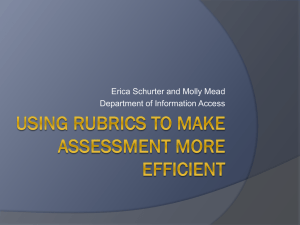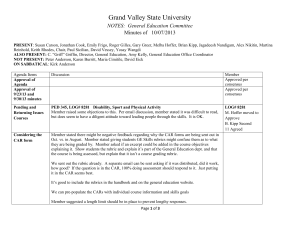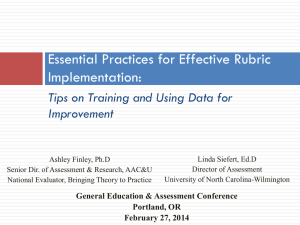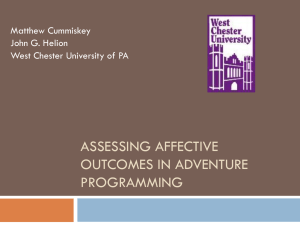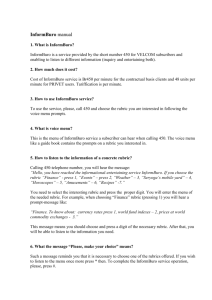Strategies to Measure Student Writing Skills in Your Disciplines
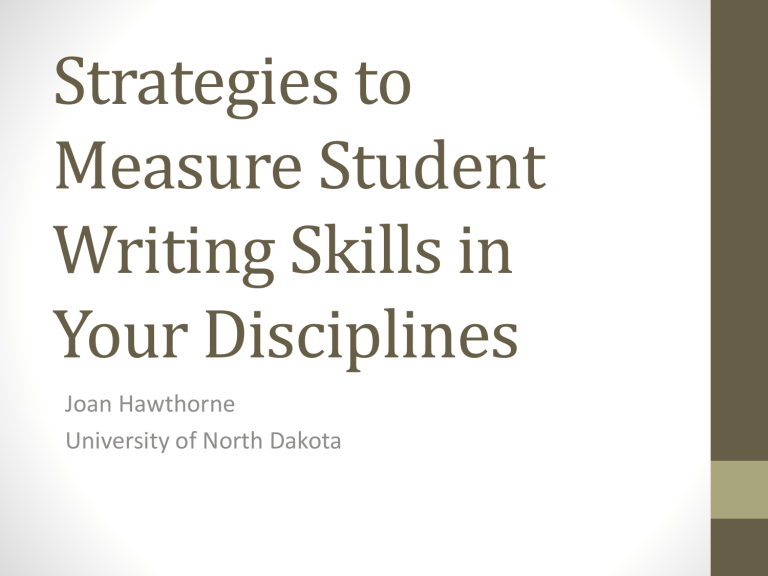
Strategies to
Measure Student
Writing Skills in
Your Disciplines
Joan Hawthorne
University of North Dakota
Today’s Agenda
• Introduction and overview
• Aligning tools and goals
• Designing and using rubrics
• Break
• Adapting rubrics to programs and purposes
• Outcomes and ownership
• Conclusions and evaluations
What’s wrong with assessment?
• Imposed
• Strategies we didn’t choose and don’t trust
• “They don’t trust us.”
• “What we need to turn in.”
• Owned
• Our own methods and our own answers
• “Let’s see how students learn.”
• “What we want to know.”
“The most important purpose of assessment should not be improvement or accountability but their common aim: everyone wants students to get the best possible education.”
Linda Suskie
Making assessment better
• Actual student work
• Actual NIU classes
• Faculty-determined criteria
• Faculty-determined “good enough” vs. “not so satisfying”
• Conclusions speak to our own students’ learning
What do we want from these assessments of written communication?
When choosing a tool…
• What questions do you want to answer?
• Why do you want to know that?
• Who will this information matter to?
• What kinds of information would be interesting and useful to those people?
Rubric options
• Traditional rubrics
• Performance lists
• Checklists
The writing shows control of sentence level features of written language
(grammar, spelling, punctuation, and usage).
Sentence level features (grammar, spelling, punctuation, and usage) are used appropriately.
Presentation, syntax, mechanics
• Uses graceful language that skillfully communicates meaning to readers with clarity and fluency and is virtually error-free
• Uses straightforward language that generally conveys meaning to readers with few errors.
Benefits of using rubrics
• They help faculty articulate what they mean and want to see.
• They help students know what to aim for.
• They focus assessment activities on student work products and student learning.
• They focus assessment on faculty judgment.
• They link outcomes across levels.
Principles of rubric use
• Don’t reinvent the wheel.
• Involve the people who’ll use it.
• Involve the people who’ll get their work scored.
• Don’t wait for the perfect wording.
• And then start tweaking….
Using rubrics in your classes
• Assume the rubric will provide grading information as well as assessment information.
• Identify criteria first.
• Know what questions you want to be able to answer.
• Use principles of backwards course design.
• Engage students with rubric criteria.
Using rubrics at the program level
• Link writing goals/criteria with program goals/criteria.
• Identify specific concerns to be addressed.
• Identify questions to be answered.
• Consider means of engaging your students.
• Consider availability of student work products.
Program level – continued
• Reach agreements regarding “traceability.”
• Consider how methodology decisions will impact participation.
• Identify range of goals addressed by the work products.
• Plan analysis
• Descriptive vs. statistical
• Course level vs. program level
Using rubrics at the institutional level
• Identify information needs for the GE program.
• Plan faculty ownership and engagement.
• Find a source of papers likely to yield useful campus-wide information.
• Build on current rubric and current data.
• Plan student participation and engagement.
Institutional level -- continued
• Involve faculty in data analysis and meaning-making.
• Involve students in consideration of data.
• Identify opportunities to feed information into campus-wide discussions.
• Consider accreditation needs.
• Remember: a key element of rubric use is that faculty judgment is central.
YOUR TASK: Form table groups or pairs. Agree on a context (i.e., course, program, institution level).
Begin planning adaptations to the
NIU communication rubric to make it usable for your questions and purposes. Be ready to tell us about what changes you made and why.
Issues to be resolved…
• How much of the rubric is relevant to our purpose?
• What’s not in the rubric that we need?
• How do we adapt for first year vs. graduating?
• How much of an issue is language which doesn’t
“feel right” in another context?
• In your context, are the additional goals which would need to be “counted” or scored, maybe at the same time as the rubric is applied?
“Assessment, one might say, must live where faculty live, in the classrooms where they teach the field they love.”
Pat Hutchings
